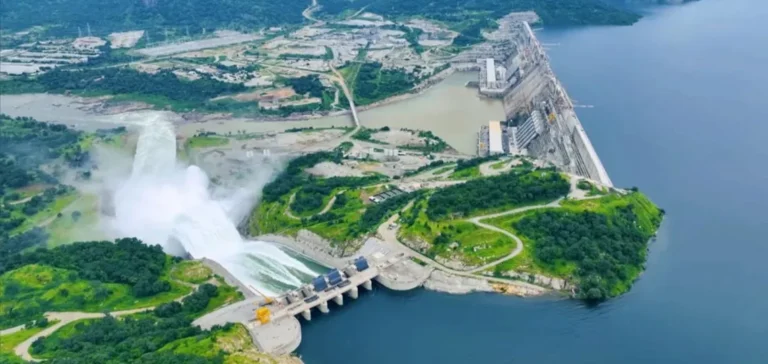Ethiopia has officially commissioned the Grand Ethiopian Renaissance Dam (GERD), located on the Blue Nile, after fourteen years of construction. This hydro project is the largest ever built on the African continent. Launched in 2011, it required an investment of USD4bn and was executed by the Italian company Webuild.
Standing 170 metres high and nearly two kilometres wide, the dam has a storage capacity of 74 billion cubic metres of water. Several turbines have been operational since 2022. The expected output reaches 5,150 megawatts (MW), more than double Ethiopia’s current electricity production capacity.
Goal: connecting millions of households
The project is presented by authorities as a strategic advance for electricity access. Around 45% of the country’s 130 million inhabitants are not connected to the grid. The GERD is expected to provide power for between 30 and 40 million people, according to estimates shared by the company overseeing construction. The Prime Minister also mentioned potential annual revenues of USD1bn through electricity exports to neighbouring countries.
The commissioning ceremony took place in Guba, attended by regional heads of state. South Sudanese President Salva Kiir announced his intention to conclude an electricity purchase agreement with Ethiopia. Fireworks and drone shows broadcast on national television accompanied the inauguration.
Ongoing tensions over Nile waters
The facility is located on the Blue Nile, which provides about 85% of the Nile’s waters. This continues to provoke opposition from Egypt, which depends on the river for 97% of its water needs. Egyptian President Abdel Fattah al-Sissi recently reaffirmed that his country would not renounce its water rights. Sudan has also raised concerns over potential impacts on its hydraulic infrastructure.
Several attempts at international mediation have failed over the past decade, despite the involvement of the United States, the World Bank, Russia, the United Arab Emirates and the African Union. No formal tripartite agreement has yet been signed between Ethiopia, Egypt and Sudan.
Commissioning amid political tensions
The GERD is one of the rare projects supported across political divides in a country marked by internal conflicts. Armed tensions persist in the Amhara and Oromia regions. Both the Tigray People’s Liberation Front (TPLF) and the ruling Prosperity Party claim credit for the project’s realisation.
The Chief Executive Officer of Webuild stated that the dam, designed exclusively for power generation, would not affect the Nile’s flow, as hydroelectric infrastructure “releases water” without consuming it. The GERD now ranks among Africa’s most imposing dams, though its capacity remains below China’s Three Gorges (22.5 GW) and Baihetan (16 GW).






















